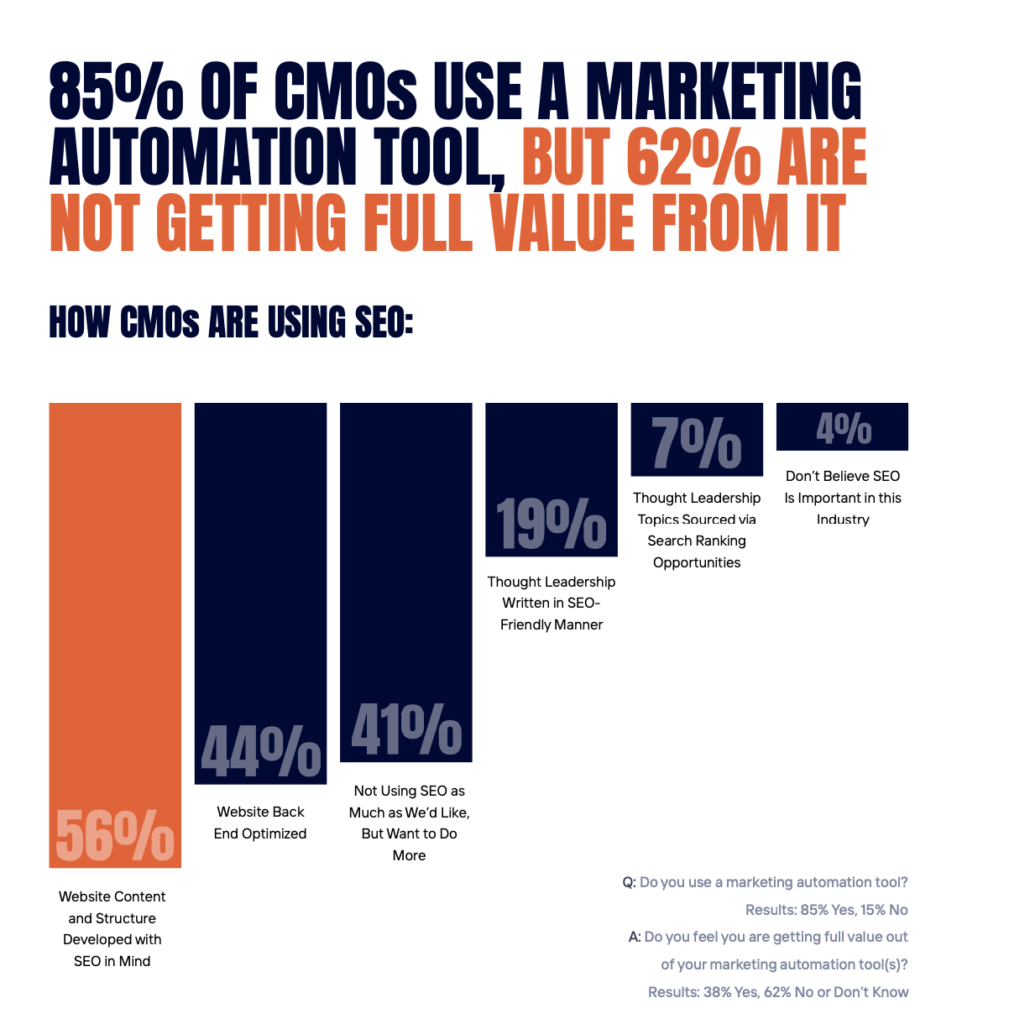Below is an excerpt from our 2022 Fintech CMO Survey Report, a deep dive into the opinions and mindsets of a wide range of senior fintech marketers. Over the next few weeks, as firms across the industry set their marketing budgets for 2023, we are highlighting some of the report’s key findings. Download the full report here.

Many companies want to leverage tactics like marketing automation, SEO and SEM more effectively, but managing these as part of a full fintech digital marketing program is easier said than done
There has been a proliferation of tools and tactics designed to get your message in front of the right people in a digital context. Marketing automation platforms such as HubSpot, Pardot and Marketo help deliver targeted content to existing contacts at the most opportune times. Other tactics, such as search engine optimization (SEO) and search engine marketing (SEM), can help flag down new contacts that have shown an interest in your business and bring them into your marketing funnel.
While the utility of these program elements will vary based on a firm’s size and strategy, they share several general commonalities: they are easy to get started on, are difficult to master and were likely not a major focus at the beginning of most senior marketers’ careers.
SEO Marketing
Our respondents were clear: these program elements have a role to play in their fintech marketing efforts. In our survey, 85% of respondents said they were using at least one marketing automation platform, while two-thirds view SEO as important to their marketing efforts (a smaller majority said the same about SEM). Well over half of the respondents are leveraging SEO for their websites in some way, whether on-page or on the back-end.
But there is another side to this dynamic. Just 38% of respondents who use an automated marketing solution felt that they get full value out of it. More than half of these respondents said they are using them only for email blasts – the most basic function of these platforms and something that can often be obtained for free through platforms like MailChimp.
On the search side, while there is broad recognition of the value of SEO, just 22% of respondents are using it to inform their thought leadership, whether for topic generation or the actual writing process. An entire 41% of respondents said that while they were not using SEO as much as they would like, they want to do more. And while the results reflected a bit more skepticism on SEM, respondents from larger firms were more likely to use it, suggesting that it is a natural route for a fintech marketing program as scale increases.
“SEO and SEM are incredibly important. When someone is searching, there’s intent, and I think the bulk of our efforts should be focused on people who are actively seeking relevant information,” said Skillman (Enfusion). “We’re in the process of significantly enhancing a lot of our demand engine capabilities and search is one area we’ve spent a lot of time focusing on in recent months. It’s a lot of effort, but I’m really confident that it will pay off.”
SEO and SEM are incredibly important. When someone is searching, there’s intent, and I think the bulk of our efforts should be focused on people who are actively seeking relevant information.”
Lorelei Skillman, Chief Marketing & Communications Officer, Enfusion
Given that, it’s not surprising that embracing these tactics is a high priority for the year ahead – in terms of where marketers plan to increase their budgets in 2022, SEO and SEM tied for the lead at 50%. But how to go about it?
Digital Marketing Tools
This is a perfect illustration of one of the key challenges facing this space today – innovation surrounding digital marketing tools and tactics has outpaced the budgets that govern them. In addition to email blasts, most marketing automation platforms offer persona-based marketing, lead scoring, behavior-based automations, and dynamic landing pages and calls to action. SEO campaigns, meanwhile, should start with a full audit, include competitive and keyword analyses and be informed by ranking opportunities.
But when resources are spread thin and numbers are strong, it’s easy to maintain the status quo, especially given the challenge of hiring someone who can truly increase bandwidth. Identifying these tactics as strategic priorities is one thing, but the day-to-day work to take full advantage is quite another.
This is one area where leaning on outside resources can really pay dividends. Working with a third party frees up marketing professionals from the time-consuming work of testing and refining what may be unfamiliar tactics – instead, they need only manage a team that has likely done the work before and can get started quickly, vouch for best practices, answer questions and the like. It’s a level of expert execution that is very difficult to replicate in-house, especially for smaller firms.
SEO for Fintech
“In 2020, we realized that we were not doing enough on SEO and SEM, both of which we felt were important arrows to add to our quiver,” said Casagrande (Confluence). “We felt the calculus for those tactics was different than for things like copywriting and digital, which can be more feasible to manage internally. SEO and SEM are so specific, such a nuanced niche, that investing in outside expertise is often a great way to make progress there.”
Read on for the next blog post in our series highlighting key insights from our 2022 Fintech CMO Survey Report, a deep dive into the opinions and mindsets of a wide range of senior fintech marketers.